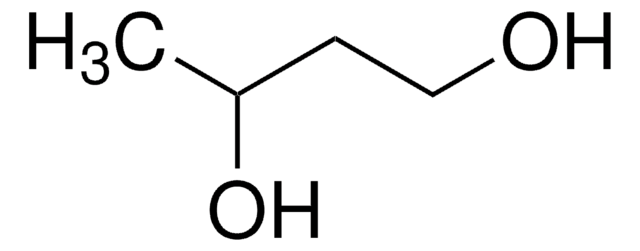1265515
USP
Ethylene glycol
United States Pharmacopeia (USP) Reference Standard
Synonym(s):
Ethylene glycol, 1,2-Ethanediol
About This Item
Recommended Products
grade
pharmaceutical primary standard
vapor density
2.1 (vs air)
vapor pressure
0.08 mmHg ( 20 °C)
autoignition temp.
752 °F
expl. lim.
15.3 %
manufacturer/tradename
USP
refractive index
n20/D 1.431 (lit.)
bp
195-198 °C
mp
−13 °C (lit.)
density
1.113 g/mL at 25 °C (lit.)
application(s)
pharmaceutical (small molecule)
format
neat
SMILES string
OCCO
InChI
1S/C2H6O2/c3-1-2-4/h3-4H,1-2H2
InChI key
LYCAIKOWRPUZTN-UHFFFAOYSA-N
Looking for similar products? Visit Product Comparison Guide
General description
Application
- Propylene Glycol
- Polyethylene Glycol 3350
- Noncrystallizing Sorbitol Solution
- Polyoxyl 40 Hydrogenated Castor Oil
- Maltitol Solution
- Sorbitol Solution
- Sorbitol Sorbitan Solution
- Dapagliflozin Propanediol
Analysis Note
Other Notes
related product
Signal Word
Warning
Hazard Statements
Precautionary Statements
Hazard Classifications
Acute Tox. 4 Oral - STOT RE 2 Oral
Target Organs
Kidney
Storage Class Code
10 - Combustible liquids
WGK
WGK 1
Flash Point(F)
239.0 °F - open cup
Flash Point(C)
115 °C - open cup
Choose from one of the most recent versions:
Certificates of Analysis (COA)
Sorry, we don't have COAs for this product available online at this time.
If you need assistance, please contact Customer Support.
Already Own This Product?
Find documentation for the products that you have recently purchased in the Document Library.
Customers Also Viewed
Protocols
99%; Glycerol, ≥99.5%; Tetraethylene glycol, 99%
GC Analysis of Class 2 Residual Solvents on OVI-G43
Our team of scientists has experience in all areas of research including Life Science, Material Science, Chemical Synthesis, Chromatography, Analytical and many others.
Contact Technical Service








